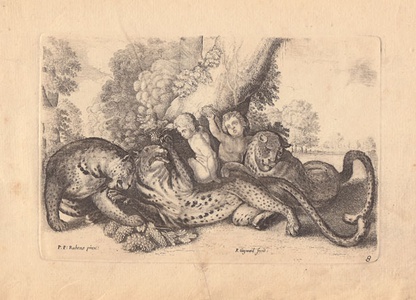| Method | Etching |
| Artist | Richard Gaywood after Peter Paul Rubens |
| Published | [London, c.1660] |
| Dimensions | Image & Plate 141 x 207 mm, Sheet 210 x 320 mm |
| Notes |
Plate 8 from Animals after Various Artists (c.1660), a collection of thirteen etchings made and published by Richard Gaywood. Richard Gaywood was a British printmaker and publisher active between 1644 and 1680. Trained by Wenceslaus Hollar, Gaywood was one of the most prolific etchers of his day. During the 1650s he took over from Hollar as the principal supplier of portrait etchings to the London trade. A friend of Francis Barlow, Gaywood produced a large number of etchings of birds and animals after him. They also worked together on a large etching after Titian's Venus and the Organist, which was dedicated to John Evelyn. Although Gaywood published plates himself, much of what he produced was made for the publisher Peter Stent. Sir Peter Paul Rubens (1577-1640) was an exponent of the Baroque style, and a pre-eminent artist of the seventeenth century. He was a leading painter of altarpieces, history painting, large-scale decorations and landscapes. Born in Germany, Rubens moved to Antwerp in around 1588, where he trained with Otto van Veen. He travelled in Italy between 1600 and 1608, where he was influenced by ancient and Italian Renaissance art. In 1609, he became court painter to Archduke Albert and the Infanta Isabella, Governors of the Netherlands for Spain. From 1628 to 1630, Rubens returned to Spain, where he met Velázquez, then came to England. A scholar, collector and diplomat, he was knighted by Philip IV of Spain and Charles I of England. Schneevoogt undescribed Condition: Crease in left half of image, small tears to bottom margin of sheet. |
| Framing | unmounted |
| Price | £95.00 |
| Stock ID | 33464 |

